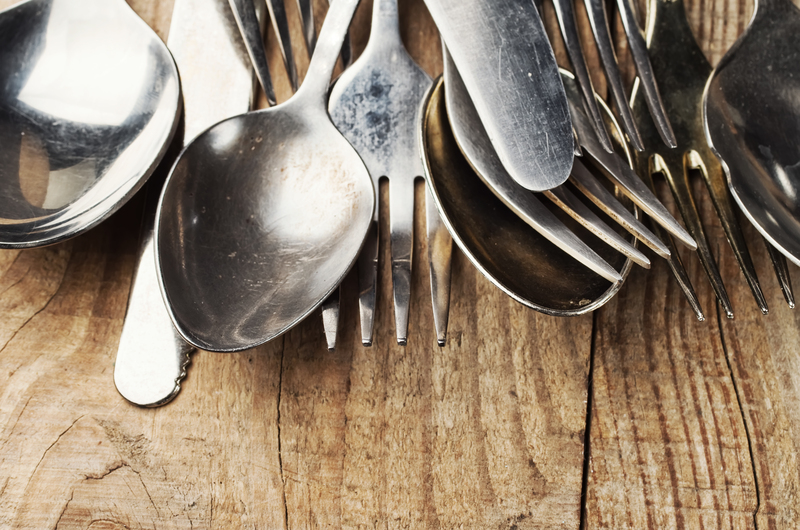Effortless Cleaning: Enamel Oven Trays Minus the Grease
Posted on 24/06/2025
Effortless Cleaning: Enamel Oven Trays Minus the Grease
Cleaning enamel oven trays often feels like a daunting chore, especially when stubborn grease and burnt-on food seem impossible to remove. Yet, with the right methods and a little know-how, you can maintain sparkling clean enamel trays with minimal effort. This comprehensive guide explores effective, gentle, and eco-friendly ways to keep your enamel oven trays grease-free, ensuring a healthier kitchen and a more enjoyable cooking experience.
Why Choose Enamel Oven Trays?
Before delving into cleaning methods, it's important to understand why enamel-coated oven trays are a staple in many modern kitchens. Enamel trays are:
- Durable: Resistant to scratches and high heat.
- Non-reactive: Suitable for acidic foods; doesn't impart metallic flavors.
- Easy to clean: Their smooth, glazed surface discourages food from sticking.
- Attractive in appearance: Available in various stylish finishes and colors.
However, even these user-friendly trays can fall victim to stubborn grease and food debris after multiple uses. Let's explore the effortless ways to restore your enamel baking trays to their original shine--minus the grease!

Understanding the Cleaning Challenges of Enamel Ovenware
Enamel oven trays offer numerous benefits but require careful handling to prevent ruining their finish. Common cleaning challenges include:
- Burnt-on grease that hardens after repeated bakes.
- Staining from sauces, marinades, or oils.
- Scratch risks from using abrasive materials or harsh chemicals.
Regular cleaning after each use is the best way to avoid these issues. But don't worry--if your tray already has baked-on residue, the solutions below will help you achieve effortless cleaning.
Preparation: Safety First Before You Start
Whenever you clean enamel oven trays, prioritize your safety and the tray's longevity:
- Cool down: Always allow trays to cool before cleaning to prevent thermal shock and potential cracking.
- Avoid harsh abrasives: Steel wool or scouring pads can damage enamel, so opt for non-scratch sponges.
- Use mild detergents: Strong chemicals can degrade enamel over time. Choose gentle, environmentally friendly cleaners when possible.
Effortless Methods for Cleaning Enamel Oven Trays
1. Soak and Swipe: The Classic Method
Sometimes, the simplest solution is the most effective. For cleaning enamel baking trays after regular use:
- Fill your sink with warm, soapy water. A squirt of mild dishwashing liquid is sufficient.
- Immerse the tray and let it soak for 15-30 minutes. This softens grease and food particles.
- Wipe with a soft sponge or cloth, focusing on greasy spots.
- Rinse thoroughly in clean water, and dry with a soft towel.
2. Bicarbonate of Soda & Vinegar: The Dynamic Duo
Baking soda (bicarbonate of soda) is famous for its gentle abrasive action and natural deodorizing properties. Paired with vinegar, it forms a fizzy, grease-busting solution--perfect for cleaning enamel oven trays minus the grease.
- Sprinkle a generous layer of bicarbonate of soda onto the cooled, greasy tray.
- Spray or drizzle white vinegar over the soda. The mixture will fizz and bubble, loosening grime.
- Let the solution sit for 10-15 minutes.
- Wipe with a non-abrasive sponge or cloth.
- Rinse thoroughly to remove all residues--even stubborn stains should lift with minimal scrubbing.
3. The Boiling Water and Detergent Approach
For enamel trays with heavy grease build-up, a combination of hot water and dishwasher detergent works wonders:
- Place the tray in your sink.
- Sprinkle dishwasher powder or add a dishwasher tablet onto the tray.
- Pour boiling water carefully over the powder, covering the worst spots.
- Let it soak for at least 30 minutes (or loosely cover and leave overnight for tough jobs).
- Scrape gently with a plastic scraper, then rinse and dry.
4. Lemon and Salt Exfoliation
If you prefer all-natural solutions, try this eco-friendly method:
- Cut a lemon in half and dip the cut side in coarse sea salt.
- Use the salted lemon as a scrubber over greasy areas. The lemon's acid breaks down stains, while salt offers gentle abrasion.
- Rinse with warm water, and buff dry for a streak-free finish.
5. Oven Tray Steam Bath
This method is perfect for mildly greasy enamel trays:
- Place the tray in a cold oven.
- Fill an oven-proof bowl with water and set it on the bottom rack.
- Heat the oven to 180?C (350?F) for around 15-20 minutes.
- The steam loosens baked-on grease. Once cool, wipe the tray clean with a damp sponge.
Pro Tips to Keep Your Enamel Oven Tray Sparkling
- Line the tray with baking parchment or a reusable silicone mat before use to prevent direct contact with food.
- Wipe off light spills while the tray is still warm (not hot) for easier cleaning.
- Avoid drastic temperature changes which can crack the enamel coating--never rinse a hot tray with cold water.
- Never use bleach as it can discolor and weaken the enamel surface.
- If you must use a commercial cleaner, pick one labeled as safe for enamel cookware.
Common Mistakes When Cleaning Enamel Oven Trays (and How to Avoid Them)
Maintaining flawless enamel trays isn't just about knowing what to do--it's also important to know what not to do.
- Using metallic or abrasive scrubbers: These can scratch and chip the enamel, leading to rust spots underneath.
- Soaking too long in water: Prolonged soaking can damage older enamel, especially if there are cracks or chips.
- Neglecting regular cleaning: The more often you clean (even lightly), the less buildup you'll face.
- Dishwasher reliance: Although some enamel trays are labeled dishwasher safe, repeated cycles may dull the finish over time. Hand washing prolongs life.
Removing Stubborn or Burnt-On Grease--Advanced Solutions
1. Baking Soda Paste
Create a thick paste with bicarbonate of soda and a little water. Spread over persistent stains, allow to stand for 15-30 minutes, then scrub gently. This approach is safe, effective, and leaves no harmful residues.
2. Commercial Oven Cleaners (With Caution)
If all else fails and your enamel tray is heavily stained, a high-quality oven cleaner suitable for enamel can help. Always follow label directions and wear rubber gloves. Avoid cleaners with caustic soda if possible--opt for those marked as "enamel friendly."
How to Keep Your Enamel Oven Trays Grease-Free
Preventative Maintenance
Keeping your oven trays in pristine condition is easier than rescuing them from layers of grease. Here's how to make cleaning truly effortless:
- Act quickly: As soon as you finish cooking, allow the tray to cool, then rinse off any visible grease or food remnants.
- Use low-grease cooking methods: Roasting on a rack above the tray, or using non-stick baking papers, keeps grease off the enamel surface.
- Periodic deep cleans: Make monthly deep cleans a habit, even if trays appear clean. This eliminates hidden buildup and maintains their shine.
Safe Storage Tips
- Store trays upright or separated by soft cloths to avoid scratching the enamel coating.
- Inspect for chips or cracks before each use--exposed metal can rust quickly.
Are Dishwasher Tablets Effective for Greasy Enamel Trays?
Many cleaning enthusiasts swear by dishwasher tablets for their easy grease removal. To use:
- Lay the enamel oven tray flat in the sink or bathtub (for very large trays).
- Place a dishwasher tablet on the greasy areas.
- Fill with hottest tap water and leave to soak for an hour.
- Wipe off grease and rinse thoroughly.
This method is particularly effective for greasy, oven-baked residues. However, always check your tray's manufacturer guidelines and ensure dishwasher tablet ingredients are suitable for enamel surfaces.
Comparing Enamel Oven Trays to Other Bakeware Materials
Why go through the effort to maintain enamel trays rather than just switch to another material?
- Aluminum: Lightweight, but can react with acidic foods, causing flavor changes and discoloration.
- Non-stick: Easy to clean when new, but the coating can wear off or get scratched, leading to sticking and flaking issues over time.
- Stainless steel: Very durable, but food easily sticks and requires more elbow grease to clean.
- Enamel: Combines the durability of metal with the smooth, stick-resistant benefits of glass. With proper care, cleaning remains virtually effortless.
Ultimately, enameled bakeware is a fantastic, long-lasting investment for anyone who values both aesthetics and easy maintenance.

Frequently Asked Questions (FAQ)
- Can I use steel wool on enamel oven trays?
No. Steel wool and other harsh abrasives will scratch the enamel, exposing the underlying metal to rust and potentially creating unsafe cookware. - What if my tray is chipped?
If cracks or chips have exposed the tray's metal base, it's best to retire it from cooking use. Exposed metal can rust and leach unwanted substances into food. - Are all cleaning products safe for enamel?
Not always. Stick to products specifically labeled for enamel cookware, and avoid bleach or caustic soda. - Can I clean enamel trays in the dishwasher?
Some enamel trays are dishwasher safe, but prolonged exposure to high heat and strong detergents may eventually dull or crack the enamel. Hand washing prolongs their life.
Conclusion: Keep It Effortless, Keep It Gleaming
Cleaning enamel oven trays minus the grease doesn't have to be a struggle. By using the right techniques--gentle soaking, baking soda and vinegar, steam baths, or dishwasher tablets--and practicing regular maintenance, you can keep your enamel trays looking as good as new for years.
Stay attentive, avoid harsh tools, and enjoy the effortless cleaning power of enamel ovenware--bake, roast, and enjoy, minus the mess! For more kitchen cleaning tips and tricks, bookmark this guide and share with your fellow home chefs.



